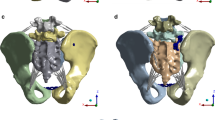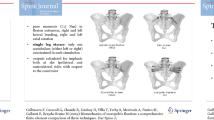Abstract
Purpose
The aim of this study was to compare the fixation power of sacroiliac rod fixation (SIRF), which was developed based on our original “within ring” concept to exclude the lumbar vertebra from the fixation range, and spinopelvic fixation (SPF) in a biomechanical experiment.
Methods
SPF and SIRF were applied to the posterior element in four bones each with the pelvic ring fracture model (AO/OTA classification 61-C1.3). A 300-N axial force was loaded on the fifth lumbar vertebra of the simulated pelvis. Then the stiffness (N/m) and deformation (mm) of SPF and SIRF were determined, and the final displacement (mm) of the fracture region and angular deformity (degrees) were measured. Displacements were measured using the markers at two sites of the sacral fracture [upper margin of the sacral ala (Ala) and second sacral vertebra level (S2)] and one site of the pubic symphysis (PS), and angular deformity was measured at Ala and PS.
Results
In SPF and SIRF, the mean stiffnesses and deformations showed no statistically significant difference. Only the vertical displacement at Ala differed significantly between SPF and SIRF (p = 0. 045), and the fixing force of SPF was higher. There was no other significant difference in vertical and horizontal displacement. The mean angular deformities also showed no significant difference between the two methods.
Conclusions
In biomechanics experiments, vertical resistance was stronger in SPF-treated than SIRF-treated bone, but stiffness and deformation, horizontal resistance, and angular deformity did not differ significantly.




Similar content being viewed by others
References
Kach K, Trentz O (1994) Distraction spondylodesis of the sacrum in “vertical shear lesions” of the pelvis [in German]. Unfallchirurg 97:28–38
Bellabarba C, Schildhauer TA, Vaccaro AR et al (2006) Complications associated with surgical stabilization of high-grade sacral fracture displacements with spino-pelvic instability. Spine 31:S80–S88
Schildhauer TA, Bellabarba C, Nork SE et al (2006) Decompression and lumbopelvic fixation for sacral fracture-displacements with spino-pelvic dissociation. J Orthop Trauma 20:447–457
Sagi HC, Militano U, Caron T et al (2009) A comprehensive analysis with minimum 1-year follow-up of vertically unstable transforaminal sacral fractures treated with triangular osteosynthesis. J Orthop Trauma 23:313–319
Bederman SS, Hassan JM, Shah KN, Kiester PD et al (2013) Fixation techniques for complex traumatic transverse sacral fractures: a systematic review. Spine 38:E1028–E1040
Lindahl J, Mäkinen TJ, Koskinen SK et al (2014) Factors associated with outcome of spinopelvic dissociation treated with lumbopelvic fixation. Injury 45:1914–1920
Konig MA, Jehan S, Boszczyk AA et al (2012) Surgical management of U-shaped sacral fractures: a systematic review of current treatment strategies. Eur Spine J 21:829–836
Pearcy MJ, Portek I, Shepherd J (1984) Three dimensional X-ray analysis of normal movement in the lumbar spine. Spine 9:294–297
Keel MJB, Benneker LM, Siebenrock KA (2011) Less invasive lumbopelvic stabilization of posterior pelvic ring instability. J Trauma 71:E62–E70
Mouhsine E, Wettstein M, Schizas C et al (2006) Modified triangular posterior osteosynthesis of unstable sacrum fracture. Eur Spine J 15:857–863
Toogood P, McDonald E, Pekmezci M (2013) A biomechanical comparison of ipsilateral and contralateral pedicle screw placement for modified triangular osteosynthesis in unstable pelvic fractures. J Orthop Trauma 27:515–520
Karakaşlı A, Ceçen B, Erduran M, Taylan O, Hapa O, Havıtcıoğlu H (2014) Rigid fixation of the lumbar spine alters the motion and mechanical stability at the adjacent segment level. Eklem Hastalik Cerrahisi 25:42–46
Lawrence BD, Wang J, Arnold PM, Hermsmeyer J, Norvell DC, Brodke DS (2012) Predicting the risk of adjacent segment pathology after lumbar fusion: asystematic review. Spine 37:S123–S132
Park P, Garton HJ, Gala VC, Hoff JT, McGillicuddy JE (2004) Adjacent segment disease after lumbar or lumbosacral fusion: review of the literature. Spine 29:1938–1944
Verga E, Hearn T, Posell J et al (1995) Effects of methods of internal fixation of symphyseal disruptions on stability of pelvic ring. Injury 26:75–80
Schildhauer TA, Ledoux WR, Chapman JR et al (2003) Triangular osteosynthesis and iliosacral screw fixation for unstable sacral fractures: a cadaveric and biomechanical evaluation under cyclic loads. J Orthop Trauma 17:22–31
Sagi HC (2009) Technical aspects and recommended treatment algorithms in triangular osteosynthesis and spinopelvic fixation for vertical shear transforaminal sacral fractures. J Orthop Trauma 23:354–360
Jazini E, Klocke N, Tannous O et al (2017) Does lumbopelvic fixation add stability? A cadaveric biomechanical analysis of an unstable pelvic fracture model. J Orthop Trauma 31:37–46
Author information
Authors and Affiliations
Corresponding author
Ethics declarations
Conflict of interest
The authors declare that they have no conflict of interest.
Ethical approval
This article does not contain any studies with human participants or animals performed by any of the authors.
Informed consent
Informed consent was obtained from all individual participants included in the study.
Rights and permissions
About this article
Cite this article
Futamura, K., Baba, T., Mogami, A. et al. A biomechanical study of sacroiliac rod fixation for unstable pelvic ring injuries: verification of the “within ring” concept. International Orthopaedics (SICOT) 42, 909–914 (2018). https://doi.org/10.1007/s00264-017-3713-x
Received:
Accepted:
Published:
Issue Date:
DOI: https://doi.org/10.1007/s00264-017-3713-x




